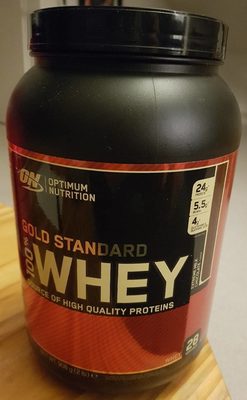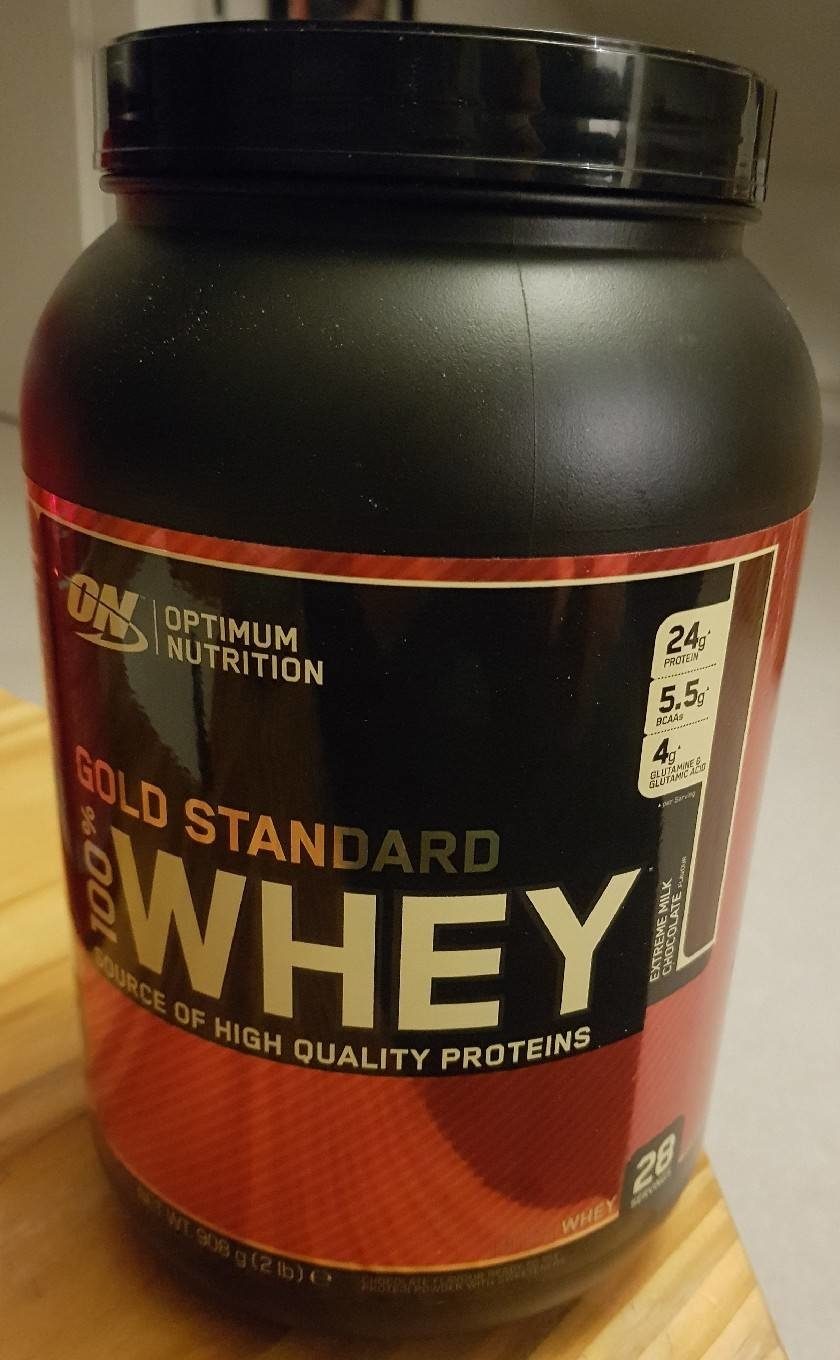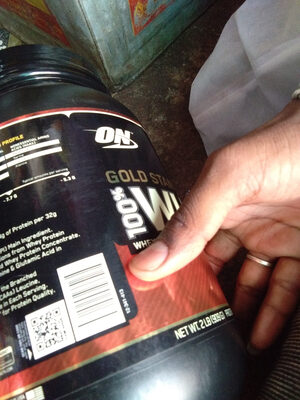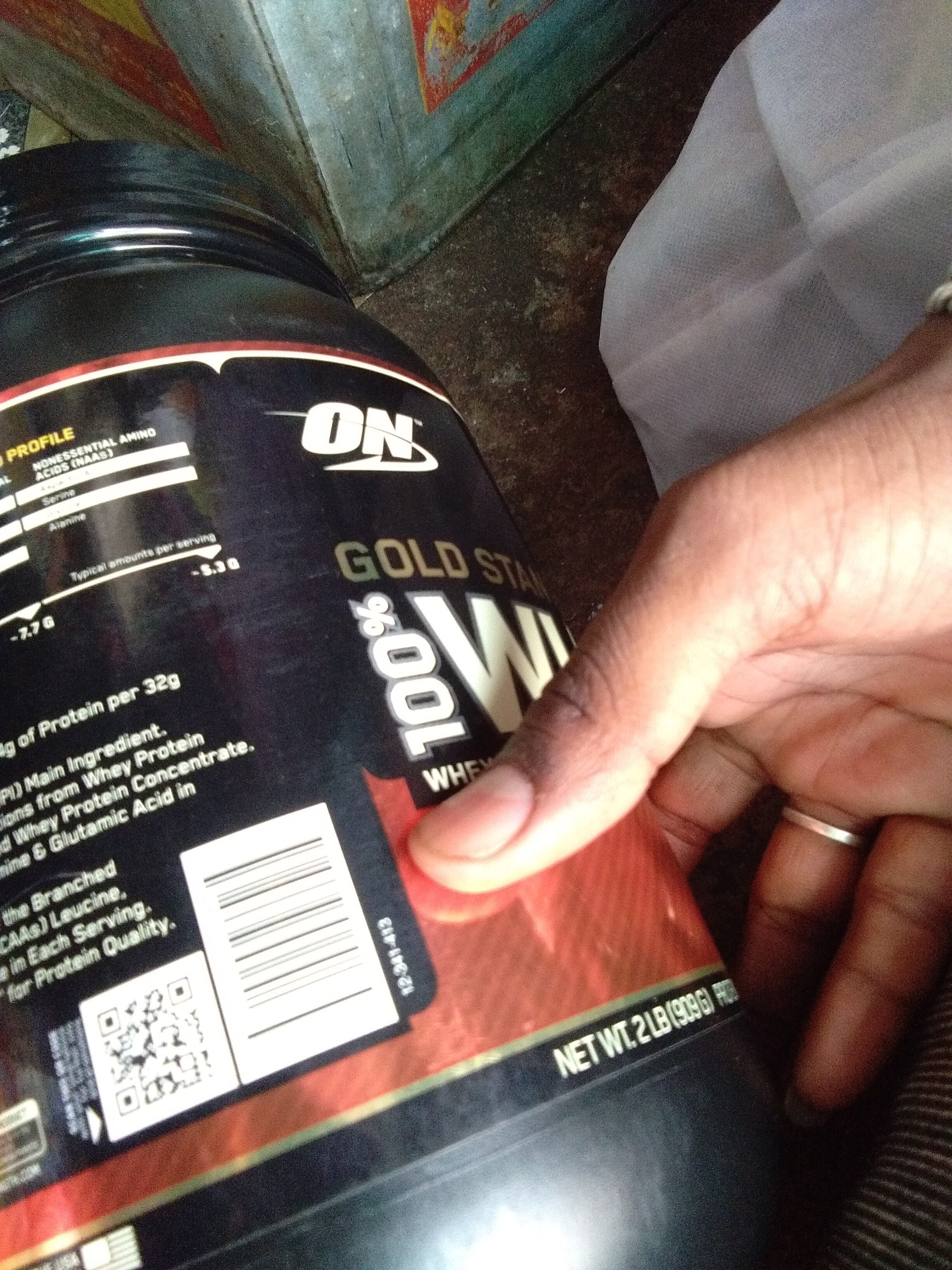Help us make food transparency the norm!
As a non-profit organization, we depend on your donations to continue informing consumers around the world about what they eat.
The food revolution starts with you!
100% Whey Gold Standard 908G Extreme Milk Chocolat - Optimum nutrition
100% Whey Gold Standard 908G Extreme Milk Chocolat - Optimum nutrition
This product page is not complete. You can help to complete it by editing it and adding more data from the photos we have, or by taking more photos using the app for Android or iPhone/iPad. Thank you!
×
Barra-kodea: 0748927024135 (EAN / EAN-13) 748927024135 (UPC / UPC-A)
Markak: Optimum nutrition
Kategoriak: Elikadura-osagarri, en:Bodybuilding supplements, en:Protein powders
Matching with your preferences
Health
Osagaiak
-
23 ingredients
: Mélange de protéines (isolat de protéines de lactosérum [émulsifiant: lécithine de soja], concentré de protéines de lactosérum, isolat de protéines de lactosérum hydrolysé) cacao maigre en poudre. arômes, colorant à café (huile de palme, maltodextrine, protéines de lait), sel, édulcorants (sucralose, acésulfame-K), complexe enzymatique (amylase, protéase, Protease, Cellulase, Beta-D-Galactosidase. Lipase).Alergenoak: en:Milk, en:Soybeans
Food processing
-
Ultra processed foods
Elements that indicate the product is in the 4 - Ultra prozesatutako elikagaiak eta edariak group:
- Gehigarria: E1104 - Lipasa
- Gehigarria: E322
- Gehigarria: E950
- Gehigarria: E955
- Osagaia: Emulsifier
- Osagaia: Flavouring
- Osagaia: Maltodextrin
- Osagaia: Milk proteins
- Osagaia: Sweetener
Food products are classified into 4 groups according to their degree of processing:
- Prozesatu gabeko edo ahalik eta gutxien prozesatutako elikagaiak
- Sukaldaritzako osagaiak prozesatu
- Prozesatutako jakiak
- Ultra processed foods
The determination of the group is based on the category of the product and on the ingredients it contains.
Gehigarriak
-
E1100 - Amilasa
Amylase: An amylase -- is an enzyme that catalyses the hydrolysis of starch into sugars. Amylase is present in the saliva of humans and some other mammals, where it begins the chemical process of digestion. Foods that contain large amounts of starch but little sugar, such as rice and potatoes, may acquire a slightly sweet taste as they are chewed because amylase degrades some of their starch into sugar. The pancreas and salivary gland make amylase -alpha amylase- to hydrolyse dietary starch into disaccharides and trisaccharides which are converted by other enzymes to glucose to supply the body with energy. Plants and some bacteria also produce amylase. As diastase, amylase was the first enzyme to be discovered and isolated -by Anselme Payen in 1833-. Specific amylase proteins are designated by different Greek letters. All amylases are glycoside hydrolases and act on α-1‚4-glycosidic bonds.Source: Wikipedia (Ingeles)
-
E1101
Protease: A protease -also called a peptidase or proteinase- is an enzyme that performs proteolysis: protein catabolism by hydrolysis of peptide bonds. Proteases have evolved multiple times, and different classes of protease can perform the same reaction by completely different catalytic mechanisms. Proteases can be found in Animalia, Plantae, Fungi, Bacteria, Archaea and viruses.Source: Wikipedia (Ingeles)
-
E1104 - Lipasa
Lipase: A lipase -, - is any enzyme that catalyzes the hydrolysis of fats -lipids-. Lipases are a subclass of the esterases. Lipases perform essential roles in digestion, transport and processing of dietary lipids -e.g. triglycerides, fats, oils- in most, if not all, living organisms. Genes encoding lipases are even present in certain viruses.Most lipases act at a specific position on the glycerol backbone of a lipid substrate -A1, A2 or A3--small intestine-. For example, human pancreatic lipase -HPL-, which is the main enzyme that breaks down dietary fats in the human digestive system, converts triglyceride substrates found in ingested oils to monoglycerides and two fatty acids. Several other types of lipase activities exist in nature, such as phospholipases and sphingomyelinases; however, these are usually treated separately from "conventional" lipases. Some lipases are expressed and secreted by pathogenic organisms during an infection. In particular, Candida albicans has a large number of different lipases, possibly reflecting broad-lipolytic activity, which may contribute to the persistence and virulence of C. albicans in human tissue.Source: Wikipedia (Ingeles)
-
E322
Lecithin: Lecithin -UK: , US: , from the Greek lekithos, "egg yolk"- is a generic term to designate any group of yellow-brownish fatty substances occurring in animal and plant tissues, which are amphiphilic – they attract both water and fatty substances -and so are both hydrophilic and lipophilic-, and are used for smoothing food textures, dissolving powders -emulsifying-, homogenizing liquid mixtures, and repelling sticking materials.Lecithins are mixtures of glycerophospholipids including phosphatidylcholine, phosphatidylethanolamine, phosphatidylinositol, phosphatidylserine, and phosphatidic acid.Lecithin was first isolated in 1845 by the French chemist and pharmacist Theodore Gobley. In 1850, he named the phosphatidylcholine lécithine. Gobley originally isolated lecithin from egg yolk—λέκιθος lekithos is "egg yolk" in Ancient Greek—and established the complete chemical formula of phosphatidylcholine in 1874; in between, he had demonstrated the presence of lecithin in a variety of biological matters, including venous blood, in human lungs, bile, human brain tissue, fish eggs, fish roe, and chicken and sheep brain. Lecithin can easily be extracted chemically using solvents such as hexane, ethanol, acetone, petroleum ether, benzene, etc., or extraction can be done mechanically. It is usually available from sources such as soybeans, eggs, milk, marine sources, rapeseed, cottonseed, and sunflower. It has low solubility in water, but is an excellent emulsifier. In aqueous solution, its phospholipids can form either liposomes, bilayer sheets, micelles, or lamellar structures, depending on hydration and temperature. This results in a type of surfactant that usually is classified as amphipathic. Lecithin is sold as a food additive and dietary supplement. In cooking, it is sometimes used as an emulsifier and to prevent sticking, for example in nonstick cooking spray.Source: Wikipedia (Ingeles)
-
E322i - Lezitina
Lecithin: Lecithin -UK: , US: , from the Greek lekithos, "egg yolk"- is a generic term to designate any group of yellow-brownish fatty substances occurring in animal and plant tissues, which are amphiphilic – they attract both water and fatty substances -and so are both hydrophilic and lipophilic-, and are used for smoothing food textures, dissolving powders -emulsifying-, homogenizing liquid mixtures, and repelling sticking materials.Lecithins are mixtures of glycerophospholipids including phosphatidylcholine, phosphatidylethanolamine, phosphatidylinositol, phosphatidylserine, and phosphatidic acid.Lecithin was first isolated in 1845 by the French chemist and pharmacist Theodore Gobley. In 1850, he named the phosphatidylcholine lécithine. Gobley originally isolated lecithin from egg yolk—λέκιθος lekithos is "egg yolk" in Ancient Greek—and established the complete chemical formula of phosphatidylcholine in 1874; in between, he had demonstrated the presence of lecithin in a variety of biological matters, including venous blood, in human lungs, bile, human brain tissue, fish eggs, fish roe, and chicken and sheep brain. Lecithin can easily be extracted chemically using solvents such as hexane, ethanol, acetone, petroleum ether, benzene, etc., or extraction can be done mechanically. It is usually available from sources such as soybeans, eggs, milk, marine sources, rapeseed, cottonseed, and sunflower. It has low solubility in water, but is an excellent emulsifier. In aqueous solution, its phospholipids can form either liposomes, bilayer sheets, micelles, or lamellar structures, depending on hydration and temperature. This results in a type of surfactant that usually is classified as amphipathic. Lecithin is sold as a food additive and dietary supplement. In cooking, it is sometimes used as an emulsifier and to prevent sticking, for example in nonstick cooking spray.Source: Wikipedia (Ingeles)
-
E950
Acesulfame potassium: Acesulfame potassium - AY-see-SUL-faym-, also known as acesulfame K -K is the symbol for potassium- or Ace K, is a calorie-free sugar substitute -artificial sweetener- often marketed under the trade names Sunett and Sweet One. In the European Union, it is known under the E number -additive code- E950. It was discovered accidentally in 1967 by German chemist Karl Clauss at Hoechst AG -now Nutrinova-. In chemical structure, acesulfame potassium is the potassium salt of 6-methyl-1‚2,3-oxathiazine-4-3H--one 2‚2-dioxide. It is a white crystalline powder with molecular formula C4H4KNO4S and a molecular weight of 201.24 g/mol.Source: Wikipedia (Ingeles)
-
E955
Sucralose: Sucralose is an artificial sweetener and sugar substitute. The majority of ingested sucralose is not broken down by the body, so it is noncaloric. In the European Union, it is also known under the E number E955. It is produced by chlorination of sucrose. Sucralose is about 320 to 1‚000 times sweeter than sucrose, three times as sweet as both aspartame and acesulfame potassium, and twice as sweet as sodium saccharin. Evidence of benefit is lacking for long-term weight loss with some data supporting weight gain and heart disease risks.It is stable under heat and over a broad range of pH conditions. Therefore, it can be used in baking or in products that require a long shelf life. The commercial success of sucralose-based products stems from its favorable comparison to other low-calorie sweeteners in terms of taste, stability, and safety. Common brand names of sucralose-based sweeteners are Splenda, Zerocal, Sukrana, SucraPlus, Candys, Cukren, and Nevella. Canderel Yellow also contains sucralose, but the original Canderel and Green Canderel do not.Source: Wikipedia (Ingeles)
Ingredients analysis
-
en:Palm oil
Ingredients that contain palm oil: Palmondo olio
-
en:Non-vegan
Non-vegan ingredients: en:Whey protein isolate, en:Concentrated whey protein, en:Milk proteinsSome ingredients could not be recognized.
We need your help!
You can help us recognize more ingredients and better analyze the list of ingredients for this product and others:
- Edit this product page to correct spelling mistakes in the ingredients list, and/or to remove ingredients in other languages and sentences that are not related to the ingredients.
- Add new entries, synonyms or translations to our multilingual lists of ingredients, ingredient processing methods, and labels.
If you would like to help, join the #ingredients channel on our Slack discussion space and/or learn about ingredients analysis on our wiki. Thank you!
-
en:Vegetarian status unknown
Unrecognized ingredients: en:Proteins mix, fr:isolat-de-proteines-de-lactoserum-hydrolyse, fr:colorant-a-cafe, fr:complexe-enzymatiqueSome ingredients could not be recognized.
We need your help!
You can help us recognize more ingredients and better analyze the list of ingredients for this product and others:
- Edit this product page to correct spelling mistakes in the ingredients list, and/or to remove ingredients in other languages and sentences that are not related to the ingredients.
- Add new entries, synonyms or translations to our multilingual lists of ingredients, ingredient processing methods, and labels.
If you would like to help, join the #ingredients channel on our Slack discussion space and/or learn about ingredients analysis on our wiki. Thank you!
-
Details of the analysis of the ingredients
We need your help!
Some ingredients could not be recognized.
We need your help!
You can help us recognize more ingredients and better analyze the list of ingredients for this product and others:
- Edit this product page to correct spelling mistakes in the ingredients list, and/or to remove ingredients in other languages and sentences that are not related to the ingredients.
- Add new entries, synonyms or translations to our multilingual lists of ingredients, ingredient processing methods, and labels.
If you would like to help, join the #ingredients channel on our Slack discussion space and/or learn about ingredients analysis on our wiki. Thank you!
: Mélange de protéines (isolat de protéines de lactosérum (émulsifiant (lécithine de soja)), concentré de protéines de lactosérum, isolat de protéines de lactosérum hydrolysé), cacao maigre en poudre, arômes, colorant à café (huile de palme, maltodextrine, protéines de lait), sel, édulcorants (sucralose, acésulfame-K), complexe enzymatique (amylase, protéase, Protease, Cellulase, Beta-D-Galactosidase, Lipase)- Mélange de protéines -> en:proteins-mix - percent_min: 37.21 - percent_max: 100
- isolat de protéines de lactosérum -> en:whey-protein-isolate - vegan: no - vegetarian: yes - percent_min: 12.4033333333333 - percent_max: 100
- émulsifiant -> en:emulsifier - percent_min: 12.4033333333333 - percent_max: 100
- lécithine de soja -> en:soya-lecithin - vegan: yes - vegetarian: yes - ciqual_food_code: 42200 - percent_min: 12.4033333333333 - percent_max: 100
- émulsifiant -> en:emulsifier - percent_min: 12.4033333333333 - percent_max: 100
- concentré de protéines de lactosérum -> en:concentrated-whey-protein - vegan: no - vegetarian: yes - percent_min: 0 - percent_max: 50
- isolat de protéines de lactosérum hydrolysé -> fr:isolat-de-proteines-de-lactoserum-hydrolyse - percent_min: 0 - percent_max: 33.3333333333333
- isolat de protéines de lactosérum -> en:whey-protein-isolate - vegan: no - vegetarian: yes - percent_min: 12.4033333333333 - percent_max: 100
- cacao maigre en poudre -> en:fat-reduced-cocoa-powder - vegan: yes - vegetarian: yes - ciqual_food_code: 18100 - percent_min: 0 - percent_max: 50
- arômes -> en:flavouring - vegan: maybe - vegetarian: maybe - percent_min: 0 - percent_max: 5
- colorant à café -> fr:colorant-a-cafe - percent_min: 0 - percent_max: 5
- huile de palme -> en:palm-oil - vegan: yes - vegetarian: yes - from_palm_oil: yes - ciqual_food_code: 16129 - percent_min: 0 - percent_max: 5
- maltodextrine -> en:maltodextrin - vegan: yes - vegetarian: yes - percent_min: 0 - percent_max: 2.5
- protéines de lait -> en:milk-proteins - vegan: no - vegetarian: yes - percent_min: 0 - percent_max: 1.66666666666667
- sel -> en:salt - vegan: yes - vegetarian: yes - ciqual_food_code: 11058 - percent_min: 0 - percent_max: 0.93
- édulcorants -> en:sweetener - percent_min: 0 - percent_max: 0.93
- sucralose -> en:e955 - vegan: yes - vegetarian: yes - percent_min: 0 - percent_max: 0.93
- acésulfame-K -> en:e950 - vegan: yes - vegetarian: yes - percent_min: 0 - percent_max: 0.465
- complexe enzymatique -> fr:complexe-enzymatique - percent_min: 0 - percent_max: 0.93
- amylase -> en:e1100 - vegan: yes - vegetarian: yes - percent_min: 0 - percent_max: 0.93
- protéase -> en:e1101 - vegan: yes - vegetarian: yes - percent_min: 0 - percent_max: 0.465
- Protease -> en:e1101 - vegan: yes - vegetarian: yes - percent_min: 0 - percent_max: 0.31
- Cellulase -> en:cellulase - vegan: maybe - vegetarian: maybe - percent_min: 0 - percent_max: 0.2325
- Beta-D-Galactosidase -> en:beta-galactosidase - vegan: maybe - vegetarian: maybe - percent_min: 0 - percent_max: 0.186
- Lipase -> en:e1104 - vegan: maybe - vegetarian: maybe - percent_min: 0 - percent_max: 0.155
Elikadura
-
Average nutritional quality
⚠ ️Warning: the amount of fruits, vegetables and nuts is not specified on the label, it was estimated from the list of ingredients: 0This product is not considered a beverage for the calculation of the Nutri-Score.
Positive points: 6
- Proteinak: 5 / 5 (balioa: 76.9, rounded value: 76.9)
- Fiber: 1 / 5 (balioa: 1.4, rounded value: 1.4)
- Fruits, vegetables, nuts, and colza/walnut/olive oils: 0 / 5 (balioa: 0, rounded value: 0)
Negative points: 10
- Energia: 4 / 10 (balioa: 1565, rounded value: 1565)
- Azukreak: 0 / 10 (balioa: 4.2, rounded value: 4.2)
- Gantz saturatua: 2 / 10 (balioa: 2.2, rounded value: 2.2)
- Sodioa: 4 / 10 (balioa: 372, rounded value: 372)
The points for proteins are counted because the negative points are less than 11.
Nutritional score: (10 - 6)
Nutri-Score:
-
Nutrient levels
-
Koipe in moderate quantity (4.1%)
What you need to know- A high consumption of fat, especially saturated fats, can raise cholesterol, which increases the risk of heart diseases.
Recommendation: Limit the consumption of fat and saturated fat- Choose products with lower fat and saturated fat content.
-
Gantz-azido ase in moderate quantity (2.2%)
What you need to know- A high consumption of fat, especially saturated fats, can raise cholesterol, which increases the risk of heart diseases.
Recommendation: Limit the consumption of fat and saturated fat- Choose products with lower fat and saturated fat content.
-
Azukre in low quantity (4.2%)
What you need to know- A high consumption of sugar can cause weight gain and tooth decay. It also augments the risk of type 2 diabetes and cardio-vascular diseases.
Recommendation: Limit the consumption of sugar and sugary drinks- Sugary drinks (such as sodas, fruit beverages, and fruit juices and nectars) should be limited as much as possible (no more than 1 glass a day).
- Choose products with lower sugar content and reduce the consumption of products with added sugars.
-
Gatz arrunt in moderate quantity (0.93%)
What you need to know- A high consumption of salt (or sodium) can cause raised blood pressure, which can increase the risk of heart disease and stroke.
- Many people who have high blood pressure do not know it, as there are often no symptoms.
- Most people consume too much salt (on average 9 to 12 grams per day), around twice the recommended maximum level of intake.
Recommendation: Limit the consumption of salt and salted food- Reduce the quantity of salt used when cooking, and don't salt again at the table.
- Limit the consumption of salty snacks and choose products with lower salt content.
-
-
Nutrition facts
Nutrition facts As sold
for 100 g / 100 mlCompared to: en:Protein powders Energia 1.565 kj
(374 kcal)+% 2 Koipe 4,1 g +% 2 Gantz-azido ase 2,2 g +% 12 Carbohydrates 7,2 g +% 2 Azukre 4,2 g +% 41 Fiber 1,4 g -% 45 Proteina 76,9 g +% 4 Gatz arrunt 0,93 g +% 20 Fruits‚ vegetables‚ nuts and rapeseed‚ walnut and olive oils (estimate from ingredients list analysis) 0 %
Ingurumena
-
Eco-Score not computed - Unknown environmental impact
We could not compute the Eco-Score of this product as it is missing some data, could you help complete it?Could you add a precise product category so that we can compute the Eco-Score? Add a category
Ontziratzea
-
Missing packaging information for this product
⚠ ️ The information about the packaging of this product is not filled in.Take a photo of the recycling information Take a photo of the recycling information
Transportation
-
Origins of ingredients
Missing origins of ingredients information
⚠ ️ The origins of the ingredients of this product are not indicated.
If they are indicated on the packaging, you can modify the product sheet and add them.
If you are the manufacturer of this product, you can send us the information with our free platform for producers.Add the origins of ingredients for this product Add the origins of ingredients for this product
Threatened species
-
Contains palm oil
Drives deforestation and threatens species such as the orangutan
Tropical forests in Asia, Africa and Latin America are destroyed to create and expand oil palm tree plantations. The deforestation contributes to climate change, and it endangers species such as the orangutan, the pigmy elephant and the Sumatran rhino.
Report a problem
-
Incomplete or incorrect information?
Category, labels, ingredients, allergens, nutritional information, photos etc.
If the information does not match the information on the packaging, please complete or correct it. Open Food Facts is a collaborative database, and every contribution is useful for all.
Datuen iturria
Product added on by kiliweb
Last edit of product page on by segundo.
Produktuaren orria -gatik editatua ann125, elcoco, openfoodfacts-contributors, thaialagata, yuka.ZW9jNk1wb2RnZjVUby9Na3hqN0h5dDFaN2J1UFZET3JjL0lBSVE9PQ.








